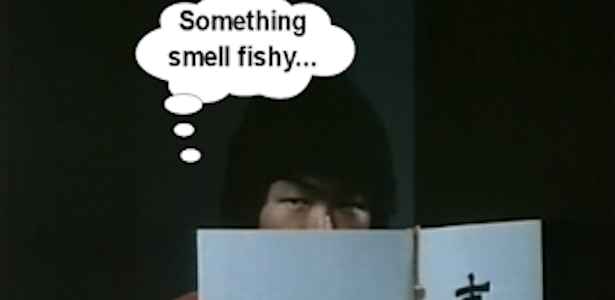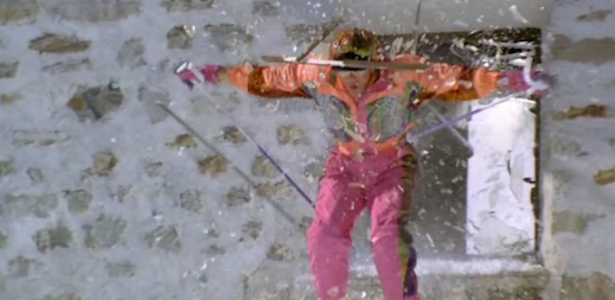One of the great things about Netflix streaming is they have a bunch of TV movies on there. Particularly interesting are TV movies from the 1970s like this little crime caper. A serious vehicle for funnyman Freddie Prinze, star of NBC’s popular CHICO AND THE MAN, this originally aired for the network on Wednesday, September 22, 1976 as the "NBC Movie of the Week." Sadly, just a few months later Prinze would be dead.
Electronics whiz and ex-con Alvin “Muff” Kovak (Prinze) plans a heist on the Chicago Transit Authority. Muff, really? Fired from the CTA for making bootleg signal boxes, Kovak figures he has enough insider knowledge that he can steal lots of money from the subway collection centers on pickup day. Muff assembles a team of four beauties to help him pull this off. There is Helen (Linda Scruggs), Lil (Christine Bedford), Jessie (a pre-GROWING PAIN Joanna Kerns) and Kitty (Brook Mills), Muff’s love interest. Because, honestly, when you are planning something so complex, you definitely want four ladies who look like they should be dancing in the disco helping you out. They get around their good looks because one of them is a make up expert and designs some intricate make ups to disguise them and make them look like old men. The end result is definitely creepy, coming off as a cross between horror movie monsters and that creepy short guy with the high pitch voice that everyone has met at some point in their lifetime. Yeah, you know the one. Here are some examples:
Anyway, Muff is one smart cookie and he bugs the office of Lt. Fogherty (Allen Garfield) in order to hear the daily numerical passwords of the pick up drivers. His plan is to intercept them by a few minutes and have one of his ladies in disguise present the code number to get the bag first. This should nab them $500,000 in three different locations for a cool million and a half dollars. Wait a second – I thought this was the million dollar rip-off, not the million and a half dollar rip-off? Anyway, all seems to be going according to plan until Luback (James Sloyan), an old underworld associate of Muff’s, shows up and demands 50% of the action. This is bad news because not only will Muff not be getting the full amount of money, but it means he has a rat in his bevy of beauties who tipped Luback off to their crime. Can Muff pull off the perfect heist, while outsmarting his enemies and uncovering the mole? I’ll bet you he can, in 73 minutes no less!
Drawing inspiration from THE TAKING OF PELHAM ONE TWO THREE (1974), this TV movie originally began its life as a screenplay by actors William Devane and John Pleshette (no doubt with themselves in the lead roles). It was eventually adapted into a TV movie teleplay by Andrew Peter Martin, who had previously given audiences the TV horror classic BAD RONALD (1974). The entire scenario can easily be seen as a big heist film, but it looks like NBC wanted to go the glorious eye candy route where a guy leads some foxy females instead. Interestingly, just two hours after this premiered at 8pm, a little show called CHARLIE’S ANGELS premiered on ABC at 10pm. *cue eerie music*
One of the things that really benefit this TV production is the location shooting in Chicago. New York usually gets the most play when it comes to 1970s urban films, so it is nice to see the Windy City get its due. There are lots of downtown shots, office layouts and, obviously, tons of railway/yard locations. If it was shot today, they would do it all location work via greenscreen and the offices would have TV screens every two feet. Most interesting to me are the garish subway station entrances that are painted with such an ugly color, looking like the kind of orange you get when you mix your mustard and ketchup (mutchup?) together.
Of course, the most interesting thing about this film is it is Prinze’s lone feature. A stand up comedian since his teens, Prinze burst into stardom after being featured on Jack Paar’s show and THE TONIGHT SHOW in 1973. Just under a year later he was the lead on the aforementioned CHICO sitcom. Sadly, the quick ascent to stardom affected Prinze adversely and he quickly fell into the drug lifestyle. Despite the birth of his son (future star Freddie Prinze, Jr.) in early 1976, Prinze continued to struggle with depression and drug abuse. It is shocking to believe, but he was only 22-years-old when he appeared in this film. Just four months after this aired, Prinze took his own life by committing suicide. It is a real shame as this film showed he was more than capable at carrying a film and that he didn’t need to rely solely on his natural comedic abilities. Had he lived, Prinze could have, at best, easily essayed supporting roles in the action flicks coming out at the time. At worst, he would have done fine in one of the AIRPORT movies. Hollywood is a land of sad stories of unreached potential and Prinze’s story might be one of the worst.
Electronics whiz and ex-con Alvin “Muff” Kovak (Prinze) plans a heist on the Chicago Transit Authority. Muff, really? Fired from the CTA for making bootleg signal boxes, Kovak figures he has enough insider knowledge that he can steal lots of money from the subway collection centers on pickup day. Muff assembles a team of four beauties to help him pull this off. There is Helen (Linda Scruggs), Lil (Christine Bedford), Jessie (a pre-GROWING PAIN Joanna Kerns) and Kitty (Brook Mills), Muff’s love interest. Because, honestly, when you are planning something so complex, you definitely want four ladies who look like they should be dancing in the disco helping you out. They get around their good looks because one of them is a make up expert and designs some intricate make ups to disguise them and make them look like old men. The end result is definitely creepy, coming off as a cross between horror movie monsters and that creepy short guy with the high pitch voice that everyone has met at some point in their lifetime. Yeah, you know the one. Here are some examples:
Hot chick in disguise or Teller?
Hot chick in disguise or Senator Joe Lieberman?
Prinze in disguise or Eddie Muprhy
in VAMPIRE IN BROOKLYN?
Hot chick in disguise or horror movie granny?
Joanna Kerns in disguise or Kramer?
Anyway, Muff is one smart cookie and he bugs the office of Lt. Fogherty (Allen Garfield) in order to hear the daily numerical passwords of the pick up drivers. His plan is to intercept them by a few minutes and have one of his ladies in disguise present the code number to get the bag first. This should nab them $500,000 in three different locations for a cool million and a half dollars. Wait a second – I thought this was the million dollar rip-off, not the million and a half dollar rip-off? Anyway, all seems to be going according to plan until Luback (James Sloyan), an old underworld associate of Muff’s, shows up and demands 50% of the action. This is bad news because not only will Muff not be getting the full amount of money, but it means he has a rat in his bevy of beauties who tipped Luback off to their crime. Can Muff pull off the perfect heist, while outsmarting his enemies and uncovering the mole? I’ll bet you he can, in 73 minutes no less!
Drawing inspiration from THE TAKING OF PELHAM ONE TWO THREE (1974), this TV movie originally began its life as a screenplay by actors William Devane and John Pleshette (no doubt with themselves in the lead roles). It was eventually adapted into a TV movie teleplay by Andrew Peter Martin, who had previously given audiences the TV horror classic BAD RONALD (1974). The entire scenario can easily be seen as a big heist film, but it looks like NBC wanted to go the glorious eye candy route where a guy leads some foxy females instead. Interestingly, just two hours after this premiered at 8pm, a little show called CHARLIE’S ANGELS premiered on ABC at 10pm. *cue eerie music*
One of the things that really benefit this TV production is the location shooting in Chicago. New York usually gets the most play when it comes to 1970s urban films, so it is nice to see the Windy City get its due. There are lots of downtown shots, office layouts and, obviously, tons of railway/yard locations. If it was shot today, they would do it all location work via greenscreen and the offices would have TV screens every two feet. Most interesting to me are the garish subway station entrances that are painted with such an ugly color, looking like the kind of orange you get when you mix your mustard and ketchup (mutchup?) together.
Of course, the most interesting thing about this film is it is Prinze’s lone feature. A stand up comedian since his teens, Prinze burst into stardom after being featured on Jack Paar’s show and THE TONIGHT SHOW in 1973. Just under a year later he was the lead on the aforementioned CHICO sitcom. Sadly, the quick ascent to stardom affected Prinze adversely and he quickly fell into the drug lifestyle. Despite the birth of his son (future star Freddie Prinze, Jr.) in early 1976, Prinze continued to struggle with depression and drug abuse. It is shocking to believe, but he was only 22-years-old when he appeared in this film. Just four months after this aired, Prinze took his own life by committing suicide. It is a real shame as this film showed he was more than capable at carrying a film and that he didn’t need to rely solely on his natural comedic abilities. Had he lived, Prinze could have, at best, easily essayed supporting roles in the action flicks coming out at the time. At worst, he would have done fine in one of the AIRPORT movies. Hollywood is a land of sad stories of unreached potential and Prinze’s story might be one of the worst.
Article around the time of
airing (click to enlarge):





































































